Equipment of the “Ice-Princess” from the Ukok-Plateau
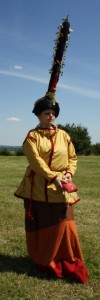 Unless otherwise stated, the objects shown are reproductions of the original state. If features such as color, object parts etc. were added by us, it is noted.
Unless otherwise stated, the objects shown are reproductions of the original state. If features such as color, object parts etc. were added by us, it is noted.
The source material for this presentation turned out to be very difficult, since most publications (particularly those of senior archaeologist Polos’mak that made the discovery of the “Ice Princess”) are in Russian. The English articles from the online accessible newspaper “Siberian Times” are recommended for an initial overview.
[peg]
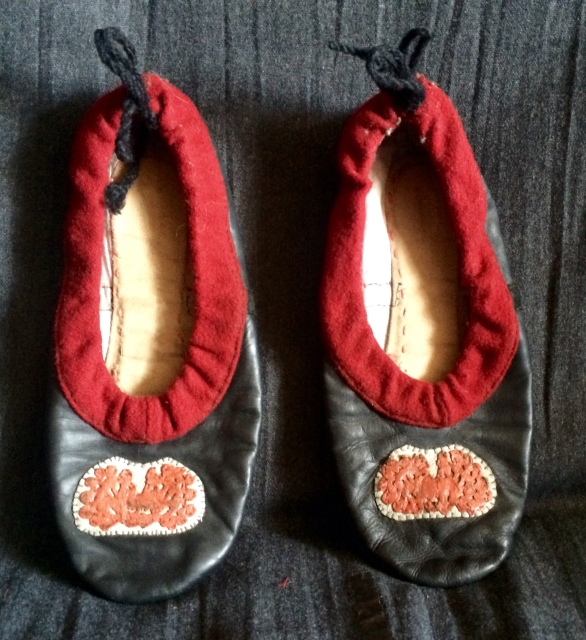 Shoes
Shoes
On her feet the “Ukok Princess” wore only some feltboots. To make the display usable, we therefore had to make shoes. Here we resorted as parallel fund on the grave of the man from Verch-Kal’džin 2, as the footwear of the Pazyryk Culture followed one hand a unified style and on the other hand made no distinction between men and women.
read on...Literature:
Molodin und Polos’mak: 2007: 147.
 Shirt
Shirt
The shirt, in which the dead was buried, was made of Indian silk and had piping and borders in red. On the sides gusset were inserted in order to guarantee freedom of movement. Striking is the center-mounted piping, which must have originally covered a seam. Like the color emphasizing the shoulder seam refers also this component to the great similarities of the garments inside the nomadic catchment area along the steppe belt.
read on...
Literature:
Polos’mak 1997: 78.
Molodin und Polos’mak 2007: 142.
Polos’mak und Barkova 2005: 71.
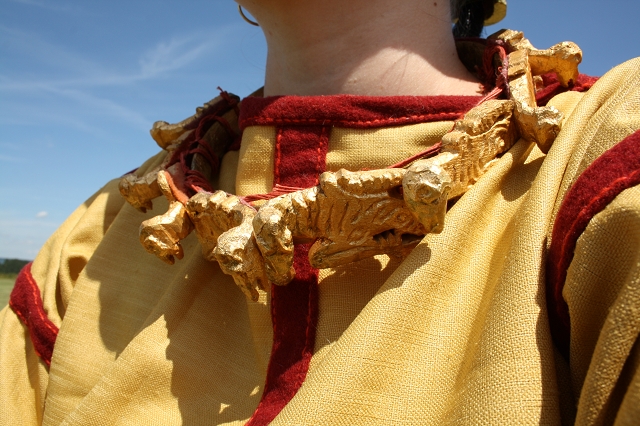 Choker
Choker
As almost all the jewelry the wife was also made of Choker of dead wood. Like the original, we use used stone pine and the hoop then gilded. The decor consists of eight intricately carved figures in the form of snow leopards.
It is believed that the lowest level of the cosmos through the Scythian Choker – Hades – is represented. He would, together with the extraordinary headgear of women form a closed system of symbols.
read on...Literature:
Molodin und Polos’mak 2007: 142f.
Polos’mak und Barkova 2005: 73.
 Stockings
Stockings
The woman wore long stockings under the skirt, made of felt that reached above the knees. With this warm legwear they must have been well protected against the cold that prevails during the winter in the Altai.
The top of the stockings was decorated with felt applications in a tendril pattern. It is worth noting that the pattern does not occur in pairs, but seems to be at one of the two stockings upside-down.
Literature:
Polos’mak und Barkova 2005: 96.
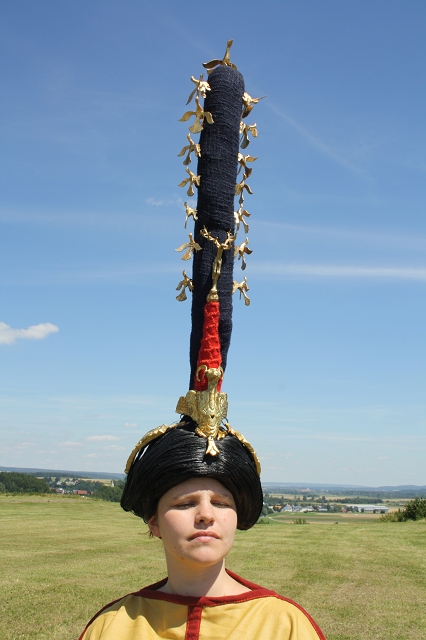 Wig
Wig
The wig is probably the most complex component in the facilities of the “Ukok Princess”. The young woman had a shaved head, on which she wore this 84 cm high construction. The core of the wig forms in the head region a clay-like, flexible mass that was originally colored black by admixing charred and crushed grains. Additionally felt was a cushioning and shaping element inside the structure.
The hair was also mounted in two layers and in different directions, so that a complex hairstyle with various pigtails could be created. Some parts of it were covered with gilded oblong wooden shells adorned with the decor of griffin-heads.
read on...
One interprets these fancy wig – as well as other pointed and sometimes very high headgear, which are known from other richly appointed nomads-graves – as a representation of the cosmological idea. Accordingly, the Scythian nomads considered the cosmos as tripartite: the top sphere of spirits, gods and demons was connoted with birds and griffins; the mean sphere of the humans was represented by ungulates and the lowest level, the world of the dead, were represented by predators and mythical creatures. This lowest level finds its expression in the prominent Choker oh the “Ukok Princess”.
Literature:
Polos’mak und Barkova 2005: 72-79.
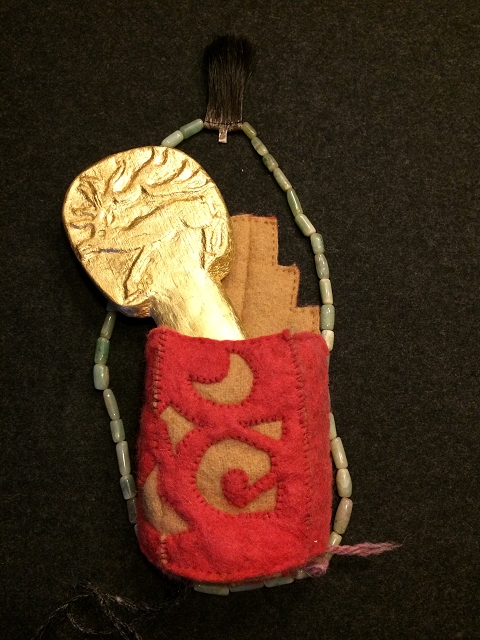 Bag with Mirror
Bag with Mirror
Near the body of the woman, a mirror was found. It was a formerly polished bronze plate, which had been inserted in a wooden frame with a handle. On the back of the gold leaf plated wooden frame a deer figure was carved.
Tucked was the mirror in a small bag made of red and beige-colored felt, which was sutured with horsehair. The unusually shaped bag has downwardly pointed stepped flab. Attached at the handle and the belt with a thread the mirror could always be quickly pulled out of the soft case.
Literature:
Polos’mak und Barkova 2005: 66f.
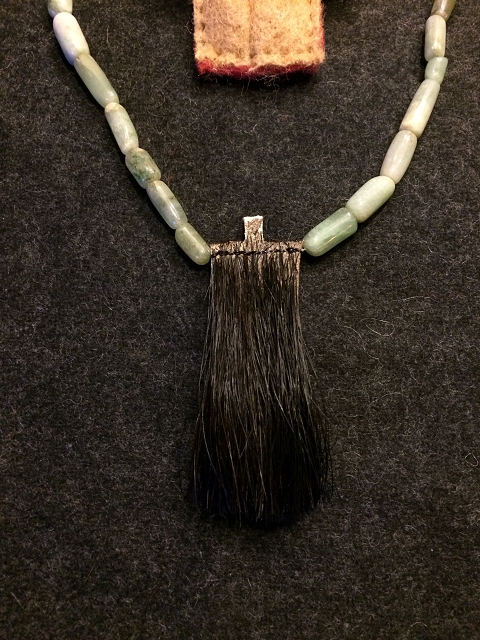 Liner (Vivianit) and tassel with stone beads
Liner (Vivianit) and tassel with stone beads
In grave of the dead the remains of Vivianit, a blue colorant, were found. Presumably it was used as a make-up. Since an iron object was found next to the colorant that is interpreted as kohl-liner, our actress has painted blue eyes. Another device for applying paint was the finding of a tassel made of horsehair, which was attached to a chain with stone beads.
read on...Literature:
Polos’mak und Barkova 2005: 67.
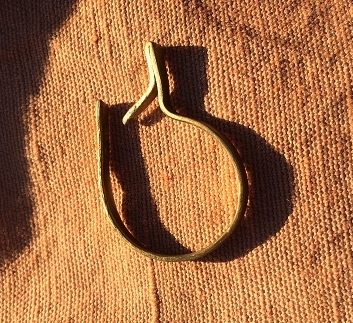 Earring
Earring
A single golden earring was also found in the grave. Whether the lack of a second earring had a special reason, it concerned a special fashion, the other earring was not added for unknown reasons or simply not found, is so far unsettled.
Literature:
Polos’mak und Barkova 2005: 73.
 Skirt and belt
Skirt and belt
The woman was wearing a – from today’s perspective – on long skirt, which was fixed just below the breast with a belt. It was manufactured of three different colored woolen cloth sheets in orange and yellow tones. Textile and dye were expensive imported goods (as madder and polish-cochineal, the latter came from Armenia). A similar skirt of comparable feature was found in the second Kurgan of Pazyryk. The banded structure is reminiscent of the skirts, which were typical of the Han time population of the Tarim Basin.
The skirt of the “Ice Princess” was formerly held by a red belt, which was manufactured in a complex weaving technique. At each end six tassels were attached.
read on...Literature:
Polos’mak 1997: 79.
Polos’mak und Barkova 2005: 62-66, 68.
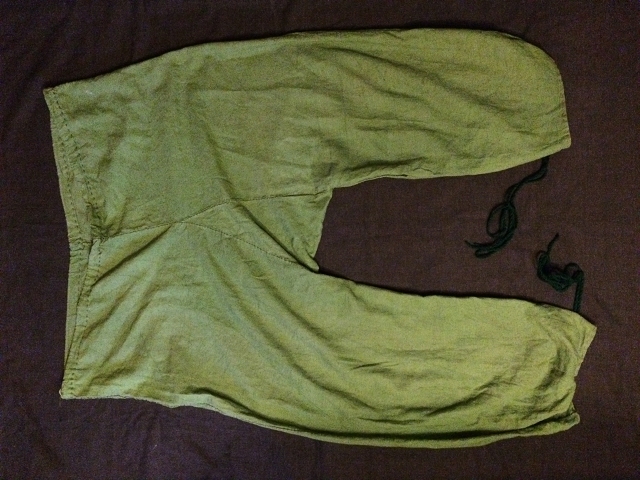 Trousers
Trousers
In addition to the long feltstockings one wore knee-length pants, as it is also known from the Iron Age Tarim Basin. In Pazyryk these pants were made of wool and were part of the men’s costume.
Literature:
Polos’mak 1997: 79.
Polos’mak und Barkova 2005: 82-85.
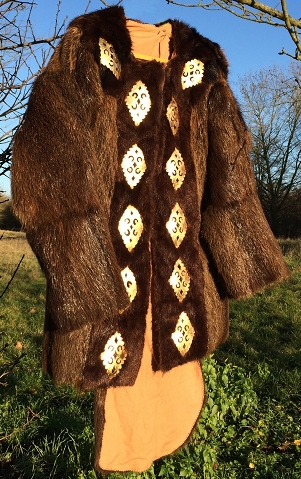 Coat
Coat
The coat was made of brown fur and had a border of darker fur along the lapel. Diamond-shaped leather applications that were originally covered with gold leaf were also attached there. We know their form from the very well preserved grave findings. Unfortunately we didn’t find more useful information about the coat which is the reason why we do not know, for example, the exact construction method. Here we focused on parallel findings from the Pazyryk culture and provided the coat with the typical “bib” on the back and very long sleeves.
weiterlesen...Literature:
Polos’mak 1997: 79.
Polos’mak und Barkova 2005: 64 und 43-61.




